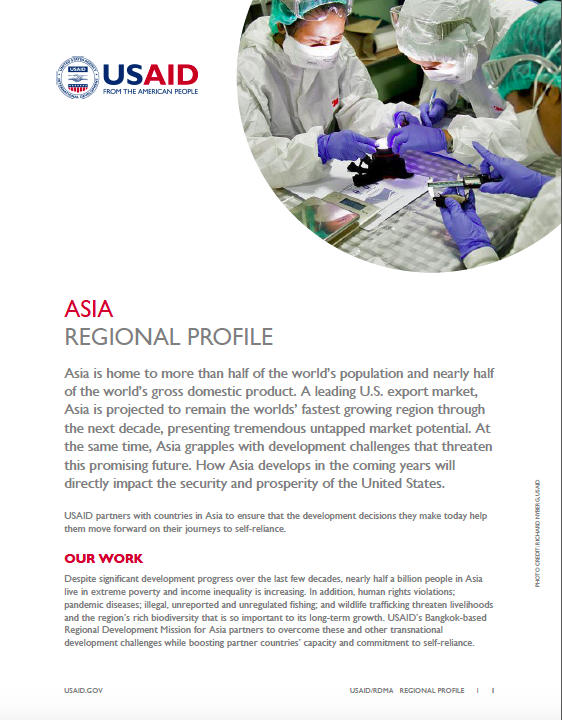Speeches Shim
Asia Regional Profile ![]() (pdf - 415k)
(pdf - 415k)
Asia is home to more than half of the world’s population and nearly half of the world’s gross domestic product. A leading U.S. export market, Asia is projected to remain the worlds’ fastest growing region through the next decade, presenting tremendous untapped market potential. At the same time, Asia grapples with development challenges that threaten this promising future. How Asia develops in the coming years will directly impact the security and prosperity of the United States. USAID partners with countries in Asia to ensure that the development decisions they make today help them move forward on their journeys to self-reliance.
OUR WORK
Despite significant development progress over the last few decades, nearly half a billion people in Asia live in extreme poverty and income inequality is increasing. In addition, human rights violations; pandemic diseases; illegal, unreported and unregulated fishing; and wildlife trafficking threaten livelihoods and the region’s rich biodiversity that is so important to its long-term growth. USAID’s Bangkok-based Regional Development Mission for Asia partners to overcome these and other transnational development challenges while boosting partner countries’ capacity and commitment to self-reliance.
ECONOMIC GROWTH
Nearly half of the world’s extreme poor live in Asia. To improve livelihoods, USAID partners with the private sector to promote inclusive economic growth. In the Lower Mekong region, for example, we are collaborating with U.S. companies like Cisco, Intel and Amazon Web Services to modernize teaching methods, giving tomorrow’s leaders the tools they need to be successful in a diverse economy while also introducing cutting-edge U.S. technology to dynamic Asian markets.
VULNERABLE POPULATIONS
USAID partners with local and international organizations to protect the rights of the most vulnerable groups in Asia, including ethnic minorities, lesbian, gay, bisexual, transgender and intersex people, and victims of human trafficking. In Asia, the International Labor Organization estimates more than 11 million people are victims of forced labor. To date, private sector contributions have helped USAID reach 675 million people with messages about safe migration through television broadcasts and online campaigns.
ENVIRONMENT
Global annual losses from illegal, unreported and unregulated fishing and seafood fraud are estimated at up to $23 billion annually. To help combat this crime in Southeast Asia — the global epicenter of marine biodiversity and seafood production — USAID is working to establish full-chain traceability that collects data from each member of the supply chain, from “bait to plate.”
HEALTH
USAID’s regional health programs aim to combat transnational health threats. For example, since 2017, more than 140,000 people in Laos and Thailand have benefitted from USAID’s HIV programs. Spurring local ownership, USAID’s viral screening techniques are now regularly used by health authorities in over 16 laboratories in 12 Asian countries to identify viruses of pandemic potential.


Comment
Make a general inquiry or suggest an improvement.